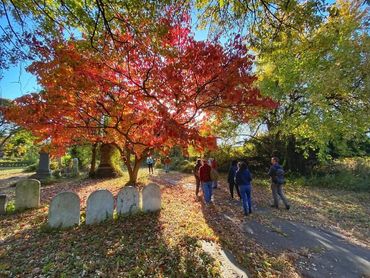NOT YET OPEN TO THE PUBLIC - Visit the 'Events' Tab for Open House Dates

A FAMILIAR FUTURE
A Renewed Vision
Described by Fanny Kemble as “a pleasure garden instead of a place for graves,” 'rural' cemeteries like Mount Vernon Cemetery redefined nineteenth century views on death and memorialization. Inspired by the gardens of Great Britain and France –namely Paris’s Père Lachaise Cemetery – Mount Auburn Cemetery – the United States' first 'rural' cemetery – infused naturalism and nineteenth century Romanticism into the American cemetery model. Featuring trails, gardens, and forests, Mount Auburn ignited the Rural Cemetery Movement, transforming the world of cemetery design. Cemeteries transitioned from overcrowded urban churchyards to large community green spaces – including Mount Vernon Cemetery – evolving into spaces of reflection and recreation. Combining landscape, architecture, and geographical aesthetics, the ‘rural’ cemetery model aligned with new, lighter perspectives on death and dying. It is in these footsteps that Mount Vernon Cemetery follows once more, intent on becoming an urban forest that embraces the living and respects the dead. Miles of trails and intimate garden settings await, merging nature and memory in a revived garden cemetery setting.
They are alive and well somewhere,
The smallest sprout shows there is really no death,
And if ever there was it led forward life, and does not wait at the end to arrest it,
And ceas'd the moment life appear'd.
All goes onward and outward, nothing collapses.
- Walt Whitman, From Leaves of Grass (1855)
A Space Where History, Nature, and Community Intertwine






Coming Back to Life: Our Progress

Gatehouse Roof Installation
Hanson Mausoleum Shutter Installation
Gatehouse Roof Installation

Hanson Mausoleum Shutter Installation
Hanson Mausoleum Shutter Installation
Hanson Mausoleum Shutter Installation

Section C Cleanup
Hanson Mausoleum Shutter Installation
Hanson Mausoleum Shutter Installation

Hanson Mausoleum Door Installation
2nd Presbyterian Church Burial Ground Cleanup
Hanson Mausoleum Door Installation

MacKellar Mausoleum Cleanup
2nd Presbyterian Church Burial Ground Cleanup
Hanson Mausoleum Door Installation

Ridge Avenue Cleanup
2nd Presbyterian Church Burial Ground Cleanup
2nd Presbyterian Church Burial Ground Cleanup

2nd Presbyterian Church Burial Ground Cleanup
2nd Presbyterian Church Burial Ground Cleanup
2nd Presbyterian Church Burial Ground Cleanup
Keep Up and Stay Connected
This website uses cookies.
We use cookies to analyze website traffic and optimize your website experience. By accepting our use of cookies, your data will be aggregated with all other user data.


